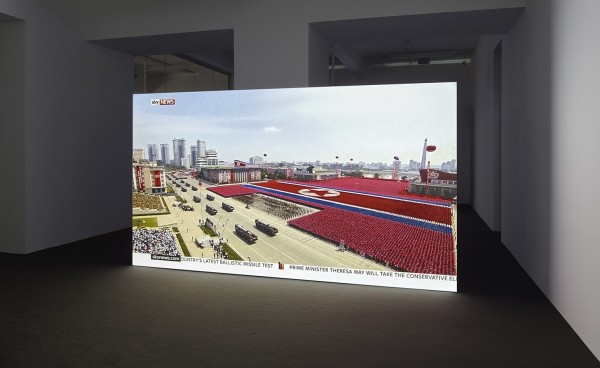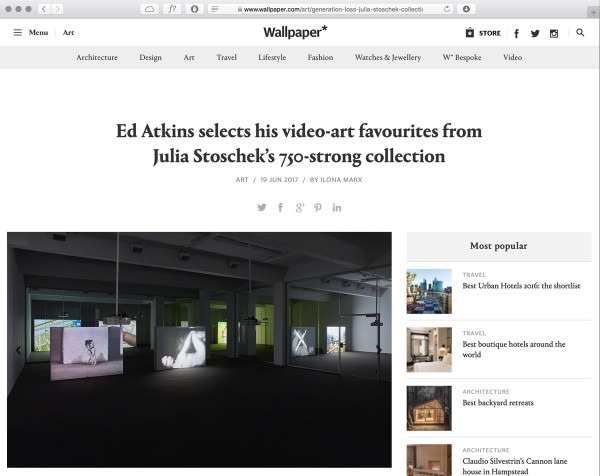Ilona Marx
Editorial work / Concepts / Texts
From the collection to the collective
Art & Culture
What are ten years in the art world, really? Quite a bit, when the genre is as young as time-based media.
Julia Stoschek is also young, at least for someone of her standing. On June 10 she will be celebrating her 42nd birthday – and at the same time, the tenth anniversary of the Julia Stoschek collection in Düsseldorf. It’s one of the most significant video art collections in the world. A novelty: For the first time, Stoschek is putting the concept of a show into the hands of an artist: The Briton Ed Atkins will be curating the Jubilee exhibition.
Stoschek is an Atkins fan. Five years ago, she devoted a retrospective to the artist, who was a mere 30 years old at the time, and she owns the largest collection of his video art. “Ed is representative of the generation of digital natives, and for me he’s an internationally significant artist’s artist.”
Atkins selected 49 works from the Julia Stoschek collection, which comprises around 750 works in all. All the videos will be shown in the same format. The large screens are uniformly aligned, so that several works can be seen at one glance. They are presented according to a certain choreography and mostly in groups of two. In this way, Marina Abramović & Ulay meet Joan Jonas, Bruce Nauman runs in parallel to Klara Lidén, and Lutz Mommartz is shown next to Paul McCarthy.

Photography: Simon Vogel
Julia Stoschek is enthusiastic about Atkins’ concept, even if she had to gut two floors of her historical building for it. Acoustic glass isolates the individual works aurally, without a visual separation. It was an undertaking comparable to constructing a new building, says Stoschek. “Ed is active in the spirit of his generation, who often work as a collective, implementing the theme of sharing in a new way and revealing a new method of communication that leads ultimately to a new design vocabulary. With his exhibition concept, he allows us an overview of the entire collection, creating a Gesamtkunstwerk in the process.“
From the collection to the collective. “The exhibition is based on a community of artists, works and ideas. The communitarian form places the pieces in an intimate relationship to each other,” says Atkins. “I have a chance to temporarily suspend whatever hegemony of the collection, reconvene the elements in a different way, asking the words to speak in a different way. I want the words to speak in ways they do not necessarily presume to: reflexively.” It’s well known that words are a major element of the Briton’s art. Last year, he even published his first literary work.
And what does he connect with the exhibition title Generation Loss? First of all the quality loss that goes hand in hand with the copying or condensing of data, also as a result of evolving technologies. In the context of the exhibition, for Atkins it is applicable to politics and culture, feelings and opinions – to social change. And it’s about the way in which artists inherit from their predecessors, how they enter into dialogue with them. Especially those from the Stoschek collection. “There is probably no art genre that has changed so significantly over the last decade as media art,” says Julia Stoschek. “From analogue VHS cassette to digital film – that was a real quantum leap. Apart from the Gutenberg printing press, in my eyes, digitisation has kicked off the largest socio-cultural shift at all.”
Indeed, the tour of the exhibition is like a historical parcours: From the beginnings of the moving image to the here and now Julia Stoschek collects everything in the context of time based media art. “I can illustrate the entire timeline of the genre in my collection: that’s important to me.” Does she dare to give a prediction for the next ten years? “Formally speaking I don’t think we’ll be looking at similarly seismic changes ahead. But things are still going to stay very exciting. Soon, for example, there won’t be any such thing as actual touchable data carriers. At the content level, an entirely new genus within the media art could evolve: Virtual Reality.”
But whatever is brewing in cyberspace – in the real world, for now, Generation Loss will be showing. For at least a year. “Time based art needs time,” is a dictum in the Stoschek Collection. And that is something she would also like to provide for Generation Loss.
Wallpaper Online
19. June 2017
